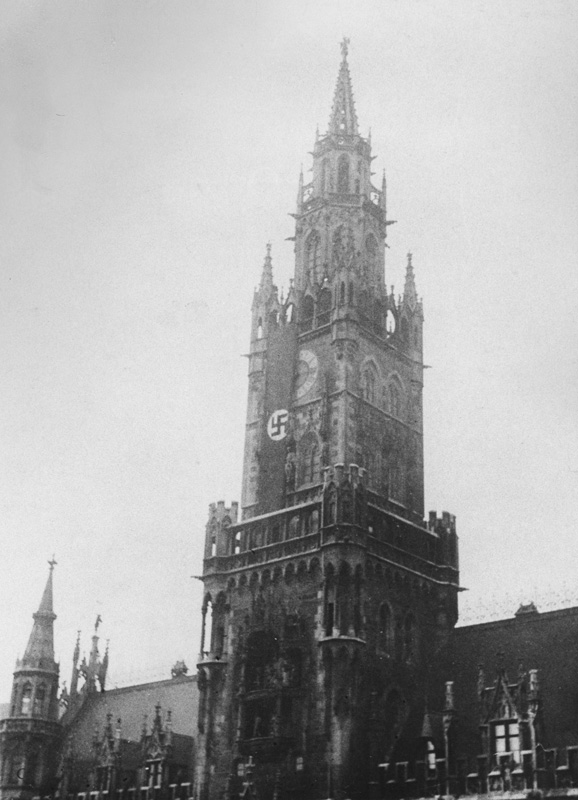Die Hakenkreuzfahne verband die deutsche Vergangenheit und Tradition, die durch die alten Reichsfarben Schwarz-Weiß-Rot verkörpert wurde, mit dem Parteisymbol des Nationalsozialismus, der sich selbst stets als Wiedergeburt der Deutschen Nation zu propagieren suchte. Der Beschluss, die Hakenkreuzfahne als Reichs- und Nationalflagge einzuführen, war Teil der ‚Nürnberger Gesetze‘ vom 15.9.1935. Juden*Jüdinnen war demzufolge auch verboten, die Hakenkreuzfahne, zum Beispiel bei Beflaggung von Gebäuden, zu verwenden. NSDAP-Mitglieder erhielten zum Ausdruck ihrer Parteizugehörigkeit ein aus Blech gestanztes Hakenkreuz, das sie sichtbar am Revers trugen. Das Jungvolk-Lied von Baldur von Schirach beschwor die Zugehörigkeit zur NS-‚Bewegung‘ mit den Worten „Unsere Fahne flattert uns voran“.
Sowohl Adolf Hitler als auch Joseph Goebbels beschäftigten sich früh mit Propaganda. Hitler war überzeugt, der Erfolg der Alliierten im Ersten Weltkrieg gehe auf die überlegene alliierte Kriegspropaganda zurück. In Mein Kampf befasste er sich ausführlich mit der planvollen und bewussten Wahl eines Parteiemblems, das sowohl für die Anhänger*innen der ‚Bewegung‘ als auch für neu zu werbende Anhänger*innen Attraktivität ausstrahlen und das Unterbewusstsein beeinflussen sollte. Er nahm für sich in Mein Kampf in Anspruch, den erfolgreichen Entwurf des Hakenkreuzes geliefert zu haben, das seit dem Sommer 1920 auf der offiziellen Parteiflagge prangte und seit 1923 im Titel des Völkischen Beobachters verwendet wurde. Goebbels hielt den propagandistischen Wert von Fahnen für größer als den von schriftlichen Werbematerialien. Fahnen wurde eine mythische Bedeutung zuerkannt: die beim ‚Hitler-Putsch‘ mitgeführte Hakenkreuzfahne wurde als ‚Blutfahne‘ bezeichnet und zur ‚Weihe‘ anderer Hakenkreuzfahnen benutzt.
Schon in der Weimarer Republik nutzte die NSDAP ein modernes und effektives Konzept für die Propagierung der nationalsozialistischen ‚Bewegung‘. Dazu gehörten Propagandamärsche, öffentliche Kundgebungen, Inszenierung von Reden und Rednern und die Agitation der nationalsozialistischen Presseorgane. Dies erforderte eine eindeutige und einheitliche Symbolik mit Wiedererkennungscharakter, die dauernd wiederholt werden konnte. Das Hakenkreuz (Swastika) eignete sich einerseits durch seine Konnotation mit den Germanen, die es als Sinnbild der Sonne und des Lebens (‚Sonnenrad‘) und Glücks- und Heilszeichen verehrten, obwohl das Hakenkreuz seit Jahrtausenden auch bei vorderasiatischen Völkern, ebenso in Indien, China und Japan die selbe Bedeutung hatte. Andererseits galt es als Gegensymbol zum christlichen Kreuz wie auch zum jüdischen Davidstern und dem Sowjetstern. Das Hakenkreuz eröffnete einen breiten und universalen Assoziationsrahmen, zum Beispiel als Zeichen für die vier Himmelsrichtungen, die vier Elemente, die vier Jahreszeiten, sogar als Symbol für die Vereinigung von Mann und Frau, und stand durch die vier nach rechts weisenden Haken und deren Rotationseffekt für Dynamik.
Der Transfer des religiösen Symbols zum politischen Emblem von Völkischen, Deutschnationalen und Antisemiten hatte bereits lange vor Hitler stattgefunden. Hitler hatte das Hakenkreuz als Erkennungszeichen gewählt, weil schon vor ihm völkische und rassistische Vereinigungen wie die Thule-Gesellschaft, Germanen-Orden oder zahlreiche Freikorps das Hakenkreuz für ihre Zwecke genutzt hatten. Zudem war es ihm mutmaßlich seit seiner Jugend vertraut, weil es im Wappen der Äbte von Lambach auftaucht, wo Hitler Ende der 1890er-Jahre Chorknabe und Messdiener gewesen war. Das Hakenkreuz als Symbol war so weit verbreitet, dass selbst die kurzlebige antisemitische Zeitschrift Der Scherer, die während Hitlers Schulzeit in Linz erschien, es verwendete. Es gelang den Nationalsozialisten, das Hakenkreuz vollständig für sich zu vereinnahmen, so dass es nicht zuletzt durch seine überall sichtbare und plakative Verbreitung wie kein anderes Zeichen den Nationalsozialismus symbolisierte und daher von den Alliierten nach 1945 energisch aus dem öffentlichen Raum entfernt wurde.
Heute ist das Hakenkreuz in Deutschland als verfassungsfeindliches Symbol verboten. Es darf nur zu Aufklärungszwecken oder zur Abwehr verfassungswidriger Aktivitäten gezeigt und verwendet werden.


